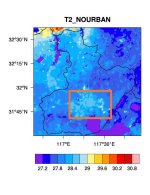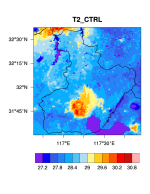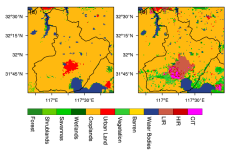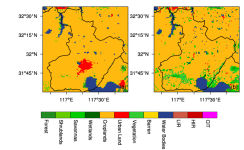kwerner said:
Hi,
1) At which stage of the WPS or WRF process did you modify the land type? Did you modify the geo_em* files, or perhaps later after running real.exe?
2) Is the temperature plot identical to the plot prior to modifying land type, or are you seeing a difference? If so, how do they compare?
3) Will you also attach your namelist.input file so that I can take a look? Thanks!
Hi,thanks for your reply.
(1)I modify land type in the geo_em* files.
(2)I attached the plot where the land type is not modified.The temperature in the urban is higher compare to that before modification.
(3)here is my namelist.input:
&time_control
run_days = 41,
run_hours = 00,
run_minutes = 0,
run_seconds = 0,
start_year = 2019, 2019, 2019,
start_month = 06, 06, 06,
start_day = 23, 23, 23,
start_hour = 00, 00, 00,
end_year = 2019, 2019, 2019,
end_month = 08, 08, 08,
end_day = 03, 03, 03,
end_hour = 00, 00, 00,
interval_seconds = 21600
input_from_file = .true.,.true.,.true.,
history_interval = 180, 180, 60,
frames_per_outfile = 8, 8, 24,
restart = .false.,
restart_interval = 7200,
io_form_history = 2
io_form_restart = 2
io_form_input = 2
io_form_boundary = 2
history_outname = './summer2019_NOURBAN/wrfout_d<domain>_<date>',
/
&domains
time_step = 150,
time_step_fract_num = 0,
time_step_fract_den = 1,
max_dom = 3,
e_we = 60, 101, 126,
e_sn = 60, 101, 126,
e_vert = 35, 35, 35,
p_top_requested = 5000,
num_metgrid_levels = 34,
num_metgrid_soil_levels = 4,
dx = 25000, 5000, 1000,
dy = 25000, 5000, 1000,
grid_id = 1, 2, 3,
parent_id = 0, 1, 2,
i_parent_start = 1, 10, 40,
j_parent_start = 1, 28, 48,
parent_grid_ratio = 1, 5, 5,
parent_time_step_ratio = 1, 5, 5,
feedback = 1,
smooth_option = 0
/
&physics
physics_suite = 'CONUS'
mp_physics = 6, 6, 6,
cu_physics = 1, 1, 1,
ra_lw_physics = 1, 1, 1,
ra_sw_physics = 1, 1, 1,
bl_pbl_physics = 1, 1, 1,
sf_sfclay_physics = 1, 1, 1,
sf_surface_physics = 2, 2, 2,
radt = 25, 25, 25,
bldt = 0, 0, 0,
cudt = 5, 5, 5,
icloud = 1,
num_land_cat = 33,
sf_urban_physics = 0, 0, 0,
/
&fdda
/
&dynamics
hybrid_opt = 2,
w_damping = 0,
diff_opt = 1, 1, 1,
km_opt = 4, 4, 4,
diff_6th_opt = 0, 0, 0,
diff_6th_factor = 0.12, 0.12, 0.12,
base_temp = 290.
damp_opt = 3,
zdamp = 5000., 5000., 5000.,
dampcoef = 0.2, 0.2, 0.2
khdif = 0, 0, 0,
kvdif = 0, 0, 0,
non_hydrostatic = .true., .true., .true.,
moist_adv_opt = 1, 1, 1,
scalar_adv_opt = 1, 1, 1,
gwd_opt = 1,
/
&bdy_control
spec_bdy_width = 5,
specified = .true.
/
&grib2
/
&namelist_quilt
nio_tasks_per_group = 0,
nio_groups = 1,
/




